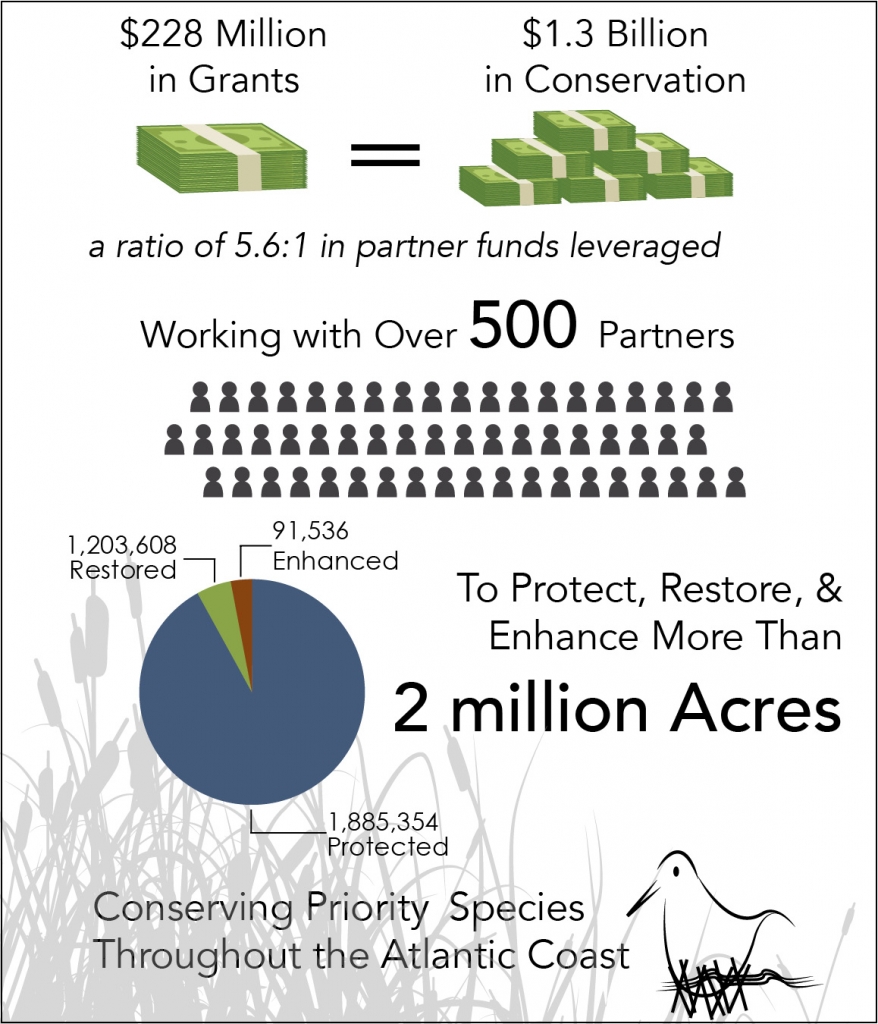Conservation through NAWCA – 30 Years of Success
What is NAWCA?
The North American Wetlands Conservation Act (NAWCA) is a U.S. Fish & Wildlife Service (USFWS) grant program that provides matching funds to organized partnerships to protect, restore, and enhance lands that benefit wetland-associated migratory birds and other wildlife.
By protecting and restoring wetlands and uplands, NAWCA supports intact, functioning ecosystems, which provide many services to society such as clean drinking water and flood protection. These direct economic benefits support multi-billion dollar industries, including tourism, commercial fisheries, forestry, and agriculture. Also, many NAWCA projects provide public access and support important traditions such as hunting, fishing, birdwatching, family farming, and cattle ranching.
NAWCA By the Numbers
The NAWCA program funds projects in the United States, Canada, and Mexico through competitive grants. Grant requests must be matched by partner contributions at least a 1-to-1 ratio. In the past two decades, NAWCA has provided $1.4 billion in grants to fund 2,644 projects in the United States. More than 5,600 partners have contributed another $3 billion in matching funds to conserve 33.4 million acres of habitat.
In the ACJV, partners have a demonstrated success in receiving NAWCA funding. Since 1991, ACJV staff have worked with over 500 partners to protect, restore, or enhance over 2 million acres of priority habitats. Partners have received over $228 million dollars in grants which have been matched by $1.3 billion in matching funds. These grants represent almost 1/3 of the grants awarded in the United States!
How to Apply for a NAWCA Grant
To learn more about the application process visit our applicant pages.

Partner Stories
320,000 Acres Conserved in South Carolina with Help from NAWCA
The South Carolina Working Group of the South Atlantic Migratory Bird Initiative has achieved amazing conservation success with the help from NAWCA grants. Audubon South Carolina, Ducks Unlimited, South Carolina Department of Natural Resources, The Nature Conservancy, and the U.S. Fish & Wildlife Service have worked together and with scores of private landowners, regional land trusts, timber companies, foundations, and local governments to protect the most important landscapes for birds, other wildlife, and people in the Ace Basin, Winyah Bay, and Savannah River Regions of South Carolina. Partners have secured more than $45 million in NAWCA grants, matched by $230 million in non-federal partner contributions. Those NAWCA grants resulted in the permanent protection, restoration, or enhancement of more than 320,000 acres, including approximately 200,000 acres in the ACE Basin, 135,000 acres in the Savannah River region, and tens of thousands of acres around Winyah Bay and the Francis Beidler Forest, recognized both as an International Important Bird Area and one of 23 Ramsar Wetlands of International Importance in the US. NAWCA grants are directly supporting the state’s multibillion-dollar tourism and fisheries industries and the thousands of jobs they support.
For their amazing contribution to conservation in South Carolina, the partnership received the National Joint Venture Conservation Champion Award in 2014.

South Carolina partners receive the National Joint Venture Conservation Champion Award.
NAWCA in Massachusetts Benefits Wildlife and People
NAWCA has been used extensively in Massachusetts, and has resulted in the protection, restoration, and enhancement of nearly 10,214 acres of valuable wetlands and adjacent upland habitats important to migratory birds.NAWCA projects in Massachusetts have directly involved dozens of different partner agencies and organizations, including Ducks Unlimited, Mass Audubon, the Office of Coastal Zone Management, The Trustees of Reservations, local land trusts, and several charitable foundations.
Check out this cool storymap that tells the NAWCA story in Massachusetts!
You can find other NAWCA stories and partner accomplishments here.
